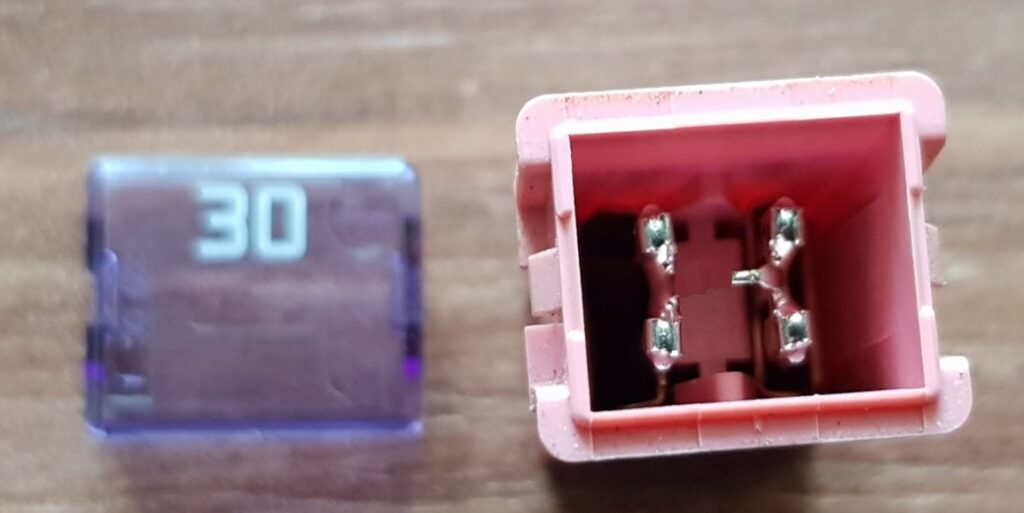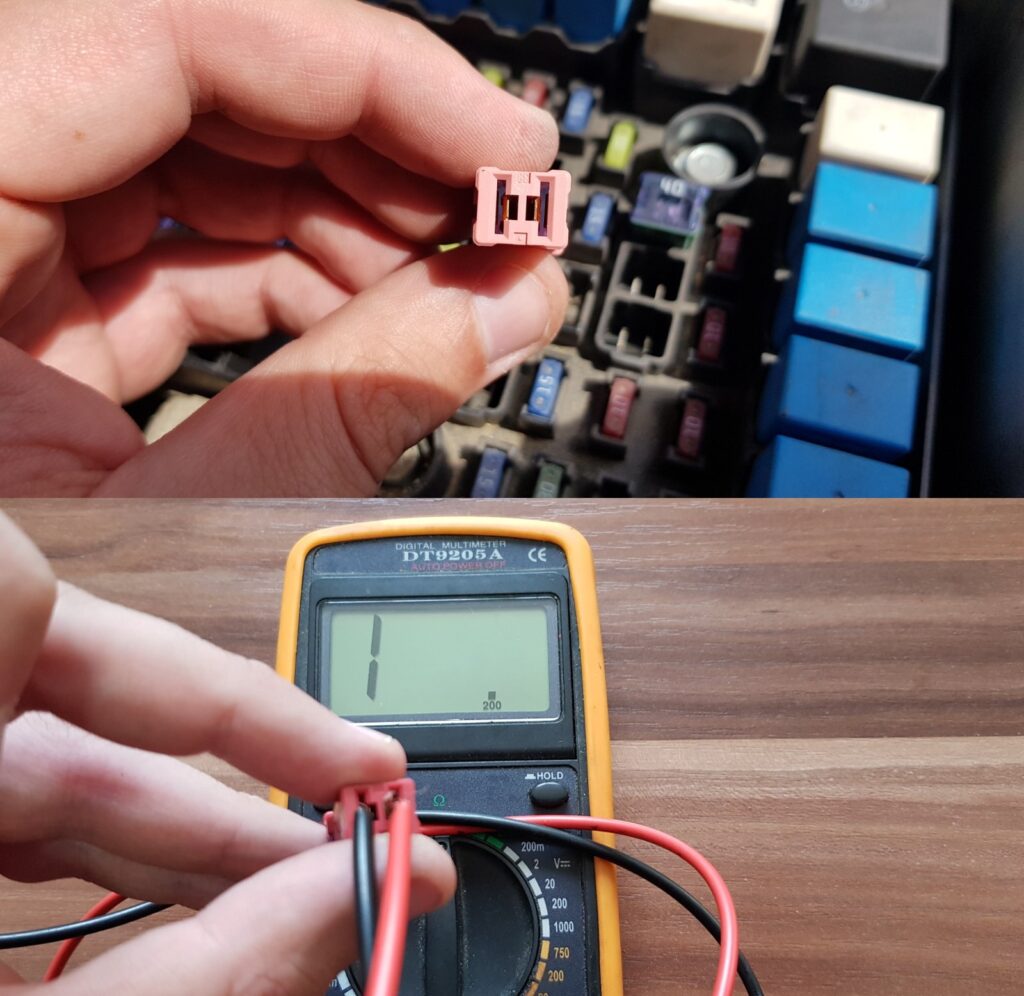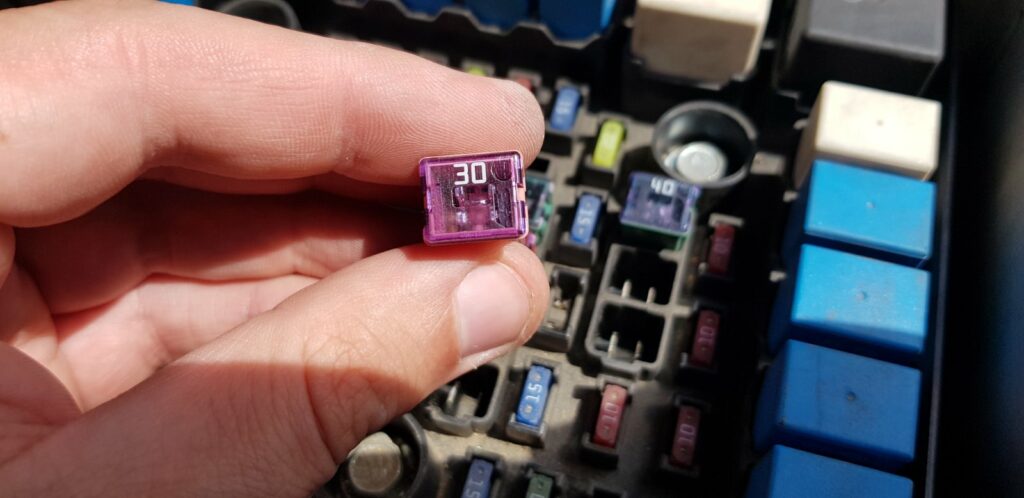Fuses were designed to act as an electrical safety device meant to blow up when in contact with a current that is higher than the fuse is designed to withstand. Many car owners deal with blown fuses. Some of them even drive with a blown fuse without knowing it.
So, what does a blown 30 amp fuse look like? How can you tell that your 30 amp fuse is blown and needs replacing?
In this blog post, I will be talking about what a 30 amp fuse is used for, what a blown 30 amp fuse looks like, and how to replace a 30 amp fuse by yourself.
- Key Takeaway
- What Is 30 Amp Fuse Used For In Cars
- What Does a Blown 30 Amp Fuse Look Like
- What Causes a Blown 30 Amp Fuse
- How To Replace a Blown 30 Amp Fuse
- How Much is a 30 Amp Fuse
- FAQs
- Q: How can I tell if my 30 amp fuse is blown?
- Q: Can a blown 30 amp fuse be repaired?
- Q: Where can I buy a replacement 30 amp fuse?
- Q: How do I replace a blown 30 amp fuse?
- Q: Are all 30 amp fuses the same?
- Q: Can I use a higher amp fuse as a replacement?
- Q: Can I use a lower amp fuse as a replacement?
- Q: Should I consult a professional if I keep blowing 30 amp fuses?
- In Conclusion
Key Takeaway
- A blown 30 amp fuse will look like having a metal strip or wire that is disconnected in the middle of the fuse itself by being blown from over current.
- You can tell that a 30 amp fuse is blown if you visually inspect it. The fuse wire that is supposed to allow current to flow through it will appear like melted/broken.
What Is 30 Amp Fuse Used For In Cars

The 30 amp fuse is used in vehicles for components that require 30 amps of electricity to run such as the AC, or the ignition. In order to protect the circuit, the fuse acts as the weakest point in the circuit.
So, when the current is too strong, the fused element inside(metal strip or wire) of the 30 amp fuse heats up and breaks. The breaking action disconnects the circuit which means electricity can’t flow through it anymore and can not damage the main component.
30 amp fuses are usually used in vehicles for electric cooling fans, heater AC blower motor, or a 500 watt sound system. However, the amperage will of course depend on the size, and the speed setting of the fans as well as the load of the sound system.
There are different types of fuses in vehicles. Some fuses are blade style while some of them are in cartridges. The fuses are also made in different colors and materials which indicates the amperage of the fuse. A 30 amp fuse is made in pink color with a blue cover on top marked with the number 30 for 30 amps.
Different components in your vehicle will require different amperages. For instance, components that don’t require a lot of electrical current like lights will have a 10 amp fuse. However, components that do require more electrical current such as the AC or ignition and possibly many others, will require a 30 amp fuse.
What Does a Blown 30 Amp Fuse Look Like

A blown 30 amp fuse typically appears as a disconnected or broken metal strip or wire in the middle of the fuse, often accompanied by signs of physical damage, discoloration, darkening, or burning.
This is where the current is running through the fuse. You can tell if a 30 amp fuse is blown by looking at it and seeing a discontinuous metal strip or wire which occurs from overcurrent. Meaning, that if the current running through the 30 amp fuse is higher, the fuse will be blown and you need to replace it.
There are a lot of types of fuses. Some are in cartridges, like the 30 amp fuse, and some are regular-looking fuses with two pins sticking out. What all fuses have in common is the metal strip or wire running from one side of the fuse to the other. Because the 30 amp fuse is usually in a cartridge, it is best if you open the cover and visually inspect it.
When comparing a new 30 amp fuse with a blown one, it is very clear to see the difference. The new 30 amp fuse has a metal strip or wire running through the middle of the fuse.
However, a blown 30-amp fuse will not have a metal strip or wire running all the way through the middle of the fuse. The metal strip or wire is going to be discontinued probably because a high current has run through it and burnt it.
However, that is exactly why fuses were built in the first place. Instead of burning the main components whenever a high current passes through, the fuse is acting as the weakest point which gets blown and discontinues the high current before it goes into the main components.
What Causes a Blown 30 Amp Fuse
- Short circuit somewhere in the system.
- Faulty converter.
- Bad battery.
- Faulty fuse replacement.
- Fraying in wire insulation causing a short circuit.
- A loose wire or one that is shorting to ground at times.
- Overloaded circuit.
- Ground fault.
- Arc fault.
- Incorrect connection of the appliance.
- Multiple appliances connected to the same fuse circuit.
- “Dead short to ground” situation, often associated with a faulty converter.
How To Replace a Blown 30 Amp Fuse

- Order a new 30 amp fuse.
- Open the hood and locate the fuse box.
- Open the fuse box and locate the blown 30 amp fuse.
- Remove the blown 30 amp fuse.
- Visually inspect the 30 amp fuse to verify that it is blown.
- Install the new 30 amp fuse.
- Close the fuse box and the hood.
Replacing a 30 amp fuse on your vehicle is very easy. However, there are some guidelines that you need to follow in order to make the replacement successful. Here is how to replace a 30 amp fuse in your vehicle:
1. Get a new 30 amp fuse
There are a lot of different fuses in the fuse box of your vehicle. Each fuse is labeled on top with the number of amps it can handle. It is very important to replace the fuse with the same amperage rating. If the amperage rating is too low, it will break too soon.
More importantly, if the amperage rating on the fuse is too high, components may fail before the fuse does.
So, before you get started, order a 30 amp fuse on amazon.com. Please note that on some vehicles, the 30 amp fuse is with a cartridge and on some is the standard fuse with two blades. Just order the exact same as your vehicle uses.
2. Open the hood

On some vehicles, there are two fuse boxes. As shown in the photo above, right above the handle for the hood there is a fuse box. However, the 30 amp fuse is usually located under the hood. So, to gain access to the fuse box, you will need to open the hood by pulling the hood latch.
3. Locate and open the fuse box

In most vehicles, the fuse box is located under the hood, on the driver’s side. The box is labeled with a fuse and relay box written on top. The fuse box is usually secured with a clip, however, some fuse boxes may be secured with bolts.
So, press the clip or remove the bolts to expose the fuses. Make sure that your vehicle is parked inside and away from any potential rain.
4. Locate and remove the faulty 30 amp fuse

Carefully observe the fuse box and locate the faulty 30 amp fuse. There is also a diagram on the cover of the fuse box that can help you in your search. Once you’ve located the 30 amp fuse, you need to remove it.
The removal of the fuse can be done by hand as shown in the photo above or you can pull it out with pliers. However, some fuses have bolts on them. When you get your new fuse, inspect it to see if it has bolts on it. The fuses with bolts on need to be pushed down so you can expose the bolts and then remove them.
This is also a good time to visually inspect the fuse. A blown 30 amp fuse will look very different from a new fuse because the metal strip that runs through the fuse itself will be disconnected/melted.
5. Test the faulty 30 amp fuse with a multimeter

On the backside of the 30 amp fuse, you will see two openings. Grab your multimeter and set it on ohms. Before you test the fuse, touch both of the wires of the multimeter in order to get a reading. The reading that you get now can be 0, 0.1, or even 1.
Remember this number because you will need to get the same number when you test the 30-amp fuse. If you get a different number in the multimeter test from the number when you test the actual fuse, it means that the fuse is blown.
So, when I tested my multimeter I got 0 ohms. Then, when I placed the wires on the backside of the 30 amp fuse, I got 1 ohm. This is a clear indication that the fuse is blown.
Usually, you can visually inspect the fuse and see if it’s blown or not. However, sometimes, the fused wire can blow in a hard-to-see spot. This is why it’s best to test the fuse with a multimeter says The Camping Advisor.
6. Install the new 30 amp fuse

Before you install the new 30 amp fuse, it is always a good idea to clean the fuse ports. Grab a dry clean towel and wipe the port.
Who knows, it could be some dirt that got into there and blew the fuse in the first place. Also, if the blown fuse has melted, make sure to clean any residue before installing the new 30 amp fuse.
Close the fuse box by reinstalling the cover and you are good to go.
How Much is a 30 Amp Fuse
A 30 amp blade-style fuse costs around $1 per fuse, whereas a cartridge-style 30 amp fuse costs around $1.50. However, fuses for vehicles are usually sold in packages of 10 or more and the price is even lower.
You will probably end up paying more for shipping than for the actual fuses. So, it is best to go and buy 30 amp fuses in your local shop or gas station.
FAQs
Q: How can I tell if my 30 amp fuse is blown?
A: To determine if a 30 amp fuse is blown, you can perform a visual inspection by checking for signs of a break in the wire or any discoloration. Additionally, you can use a multimeter to test for continuity across the fuse terminals.
Q: Can a blown 30 amp fuse be repaired?
A: No, a blown 30 amp fuse cannot be repaired. Once a fuse is blown, it needs to be replaced with a new one of the same amperage rating.
Q: Where can I buy a replacement 30 amp fuse?
A: You can purchase a replacement 30 amp fuse at hardware stores, automotive supply stores, and online retailers. They are commonly available in packs or individually.
Q: How do I replace a blown 30 amp fuse?
A: To replace a blown 30 amp fuse, locate the fuse box in your electrical panel or device. Turn off the power to that circuit before removing the blown fuse. Simply extract the blown fuse and insert a new one of the same amperage rating in its place.
Q: Are all 30 amp fuses the same?
A: No, while 30 amp fuses serve a similar purpose, they may have different features depending on their intended application. It is essential to use the correct amperage and type of fuse recommended for your specific electrical system.
Q: Can I use a higher amp fuse as a replacement?
A: No, it is not recommended to use a higher amp fuse as a replacement for a blown 30 amp fuse. Fuses are designed to protect the circuit from excessive current flow, and using a higher amp fuse can lead to damage or fire hazards.
Q: Can I use a lower amp fuse as a replacement?
A: No, it is not advisable to use a lower amp fuse as a replacement for a blown 30 amp fuse. The lower amp rating may not provide adequate protection for the circuit, causing it to overload and potentially leading to equipment damage or fire hazards.
Q: Should I consult a professional if I keep blowing 30 amp fuses?
A: If you consistently experience blown 30 amp fuses, it is recommended to consult a professional electrician. They can assess the electrical system, identify potential issues, and provide appropriate solutions to prevent future fuse blowouts.
In Conclusion
A blown 30 amp fuse will appear to have a blackened or discolored metal strip indicating an overload.
When this happens, it is important to replace the fuse with one that matches the amperage and voltage rating of the original fuse.
Additionally, any wiring connected to the circuit should be carefully inspected for signs of damage before replacing the fuse.
